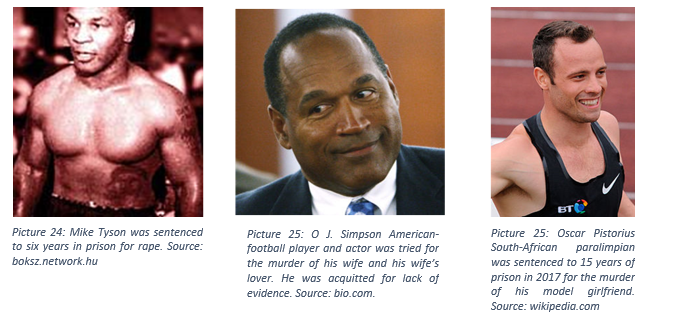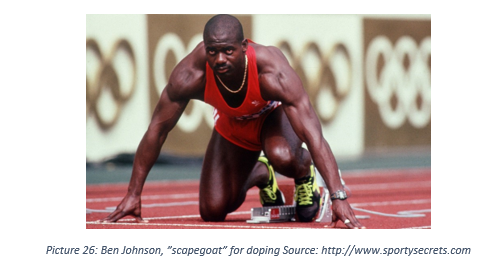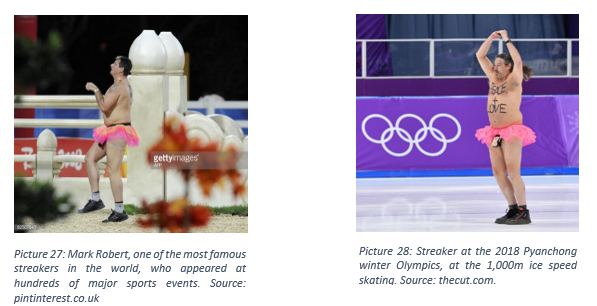10. Deviances in Sports
Deviances are forms of behaviour that violate the current and valid norms and standards of society, and go against the value system of the community. In the world of sports, as we have seen, deviances appear in a special way, since there are sports in which aggressive behaviour, or even ”physical violence” are part of the activity itself (e. g. martial arts). Although straightforward aggressivity, too hard play may infringe the rules of the game, it is expected by the coaches as well as the audience. They believe this is the way the team, or the sportsperson, will reach victory. The appearance of the different forms of deviance in sports causes a variety of problems. The deviances of famous professional sportspeople question the positive role of sport as a means of developing one’s personality and conveying values. Beacuse of that, many people will be disappointed and turn away from sport (Gál 2015).
10.1. Deviant athletes
”The manipulated hedgehog was at the finish line when the control rabit did not even start” (Manfred Donike)
Deviances in sport usually fall into two major categories. The first is when some form deviance appears within sport itself. The other is when some sort of deviance infiltrates into sport from the external world. Those who suffer from that sort of deviance may be sportspeople, coaches, trainers, sports managers or supporters etc. (Gál 2015). After an analysis of the deviances of sportspeople and the deviances that appear in sports, Smith (1983 quoted by Gál 2015) identified four categories:
1.Brutal body contacts: it includes the contact sports that include direct physical fight (box, mixed martial arts, other martial arts and some team sports, such as rugby, American football, ice hockey, etc.). These are not to be regarded as deviances. What is more, a social-historical analysis of the fighting sports and martial arts shows that these sports offer a ”legal framework” to act out violent instincts since wars, including body to body fight, have vanished from civilization.
2.Borderline violance: foul movements committed by sportspeople that break the rules, but that are acceptable in certain cases, or even desirable in the eyes of the fellow sportspeople, coaches and supporters (e. g. at a free kick in football, or in handball in front of the goal, tumultuous scenes of the defenders when they are pushing about, bumping into each other etc.).
3.Quasi-criminal violence: these forms of behaviour do not simply violate the rules of the sport and the spirit of fair play, but reach the borderline of criminal acts in the civilian life as well (such are tha cases when sportspeople attack each other in the heat of the moment. For instance, at a car race Michael Simko and Don St. Denis crashed out of the latter’s fault, and Simko kicked out the windshield of Densi’s car, and then attacked the pilot).
4.Straightforward criminal acts: behaviour, activity and acts of sportspeople that are officially persecuted by the law in the civilian life (e. g. when ZINADINE ZIDANE HEADBUTTED MATERAZZI (video) at the final of the 2006 football world championship, or when MIKE TYSON BIT OFF EVANDER HOLYFIELD’S EAR (video) at a professional box world championship title match).
Sometimes sportspeople take this kind of agressivity outside the world of sport. A number of cases have been recorded in the past few decades when sportspeople clashed with the law, and went to trial, and even to prison (the examples below illustrate such cases). It is to be noted, however, that these kinds of deviance are primarily linked to well-known professional sportspeople–in their sport career or in their private life–and the intensive media attention makes them widely known to the public. Such media attention almost never occurs in the world of amateur sport (Földesiné et al. 2010).

But not only sportspeople may commit crimes; sometimes they fell victims to different violent actions. Such a case was when Monika Szeles was backstabbed by a Steffie Graf-fan at a tennis tournament. Even more tragic was the instance when a football player called Andres Escobar was murdered by a supporter because the player scored a self-goal at the cup final.
The most common crimes against sportspeople include those when people in higher, more senior or more powerful positions (trainers, coaches, managers, club leaders etc.) use their position to harass sportspeople mentally, physically or even sexually. They blackmail sportspeople in exchange for admitting them in a club or allowing them to enter a tournament. They may also use overtly brutal and violent methods spurring them to achieve better and better results (this is, among other things, what the Hungarian movie titled FEHÉR TENYÉR [White Palm] is about). Special cases are the excessively rude and sometimes even violent and humiliating ”inauguration” rituals at the beginning of one’s sport career that people have to undergo in order to be allowed to become a member of the community (Gál 2015).
10.2. Deviances in the World of Sport
We cannot escape seeing that the excessively optimistic ideas of the father of modern Olympics regarding sports are not fully valid in our days. As the Olympic games are now valued very high and a lot of sports have become highly professional, sportspeople are very strongly success-oriented in our days. The pursuit of performance means that human strength and abilities are very often nothing more than marketable products. As economy, media and politics are involved, some of the competitive sports are frequently considered as mere businesses. Since performance has gained such a weight, and sportspeople are measured by their performance, doping is spreading, and the production and use of dope is a prosperous industry. The use of performance improving substances is against the principle of fair play as Coubertin saw it, since it means an advantage that leads to a higher performance and victory. It is obvious that the use of such substances is cheating, and in most cases the law punishes doping. There are also the harmful effects of dope on the physics of sportspeople. Some of these substances are not only hazardous, but may be lethal to the user. Still, a high number of sportspeople uses it and, what is worse, they even regard it as a pardonable sin. Sportspeople and their coaches accept the use of prohibited substances as some sort of a norm, saying that ”everybody uses something,” it is therefore indispensable to achieve a better result. In this way, unequal chances do not appear because some of the sportspeople achieve unfair advantages, but because some of them do not use any dope and fall back in the competition. Society is unwilling to condemn the use of dope very strongly; people often side with the sportsperson for some misinterpreted patriotism or love of sport. They often regret more that the sportsperson is caught than the fact that the person used a prohibited substance (Földesiné Szabó et al. 2010).
Doping is in fact as old as sport itself: performance enhancing substances were used in the antiquity. For instance, one of the most well-known wrestling champion, Milón, satisfied his need of protein by eating a large amount of calf (according to contemporary records, he consumed as much as 9-15 kg of it a day). In the history of modern Olympics, the International Olympic Committee began serious fight against dope, performance enhancers and narcotics in the 1960s. The first general dope control was conducted by the World Anti-Doping Agency (WADA) at the 1968 summer Olympics in Mexico. At the 1976 Montreal Olympics the first dope list was published. Perhaps the gravest global doping scandal is attached to the name of Ben Johnson, who had WON THE 100-m SHORT-DISTANCE RUNNING (video), with a new world record, below 10 sec, for the first time in history, at the 1988 Seoul Olympics, and two days later steroid was detected in his urine. The case echoed throughout the whole world, and it was a turning point in the fight against doping. The problem raised to a social level, as the world realized what a serious problem the use of controlled performance enhancing substance in competitive sports is. Ben Johnson was a scapegoat, his results were cancelled, his Olympic gold medal withdrawn. The reason why Johnson’s downfall was given a much bigger publicity than similar cases was that his case made it evident that the production and use of dope is now an effective, multi-player, well organized business, in which developers and manufacturers of the substances, doctors, coaches, trainers and, last not least, a lot of sportspeople are involved. The question first appeared whether it was possible to achieve outstanding results in competitive sport ”clean,” without the use of some dope.

Another form of deviance, specific to sports, is football hooliganism, vandalism, violence on the side of the supporters (that may also occur in other sports as well). The fans of rival teams engage each other in a fight, they curse and throw things at each other, offending the human dignity of the players of the opposing team, they often chant racist rhymes. Such actions are usually instigated by the so-called ”hard core” of the fans, and sometimes they try to infiltrate into the ranks of the fans of the rival team during a match in order to provoke a conflict. These fans watch the game and the supporters of the rival team simultaneously, and in this way hooliganism becomes an organic part of certain matches (Dunning 2002).
FOOTBALL-HOOLIGANS IN ENGLAND (video, part one of the series)
Football-hooliganism is a problem in Hungary, too. It is not restricted to physical violence, but there are anti-semitic, racist and xenophobic remarks shouted from the audience. The verbal assault is directed to the fans and players of the rival team, the referee etc. The agressive fans express their opinion verbally, on posters and even on their clothing. They do not balk at throwing different objects in the pitch (see the video inserted into Chapter 6.4) (Földesiné Szabó 1996).
The reasons of the agression of supporters are probably rooted in the macro-processes of society, since these phenomena did not origginally appear in sports. They have been a part of people’s daily life, and that is where sport absorbed them from. This attitude of the supporters is typically a way people in the lower social classes give vent to their frustration coming from their special socio-cultural situation. Furthermore, it is one of the ways they establish and reinforce their identity. It is inevitable to treat the problem, since as a consequence of the negative phenomena, the number of supporters dropped considerably (also) in Hungary, and their social composition changed. Those who remained, typically come from lower social strata, open to deviances, and the middle-class people were deterred away (Földesiné Szabó 1994).
A special group of offenders around sport are those who commit public indecency, the so-called streakers, who disturb the play by running into the field naked, underdressed or in some strange outfit. An important difference between the streakers and the aggressive supporters is that the streakers do not wish to hurt anyone; their goal is ”simply” draw a wide public attention onto themselves.

Control questions
Describe some deviant sportspeople!
Why is it iportant to fight doping, and what forms of the fight are available at present?
What deviances of supporters can you mention? Describe these!